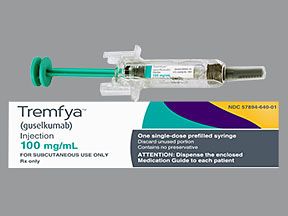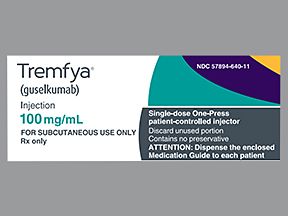Tremfya (guselkumab) is a prescription drug that’s used to treat certain inflammatory conditions, such as psoriatic arthritis. Tremfya comes as a liquid solution for injection.
This drug is used in adults for:
- active psoriatic arthritis
- moderate to severe plaque psoriasis, if a person can use certain other treatments for this condition
- moderate to severely active ulcerative colitis (UC)
If you’d like to know about these conditions and how Tremfya is used for them, see the “What is Tremfya used for?” section.
Tremfya basics
Tremfya comes as a liquid solution for either injection under your skin or intravenous (IV) infusion, which is an injection into a vein given over time. (The infusion is used only for UC at the start of treatment.)
Tremfya contains the drug guselkumab, which is a biologic medication. A biologic is made from parts of living cells.
Tremfya isn’t available in a biosimilar form. (Biosimilars are like generic drugs. But unlike generics, which are made for nonbiologic drugs, biosimilars are made for biologic drugs.) Instead, guselkumab comes only as the brand-name drug Tremfya.
Like most drugs, Tremfya may cause mild or serious side effects. The lists that follow describe some of the more common side effects that Tremfya may cause. These lists don’t include all the possible side effects.
Your doctor or pharmacist can tell you more about the potential side effects of Tremfya. They can also suggest ways to help reduce the side effects.
Mild side effects
Here’s a short list of some of the mild side effects that Tremfya can cause. To learn about other mild side effects, talk with your doctor or pharmacist, or read Tremfya’s medication guide.
Mild side effects of Tremfya can include:
- upper respiratory infections,* such as the common cold
- the stomach flu
- discoloration, swelling, or pain at the site of Tremfya injections
- joint pain
- herpes simplex infection
- headaches
- fungal skin or nail infections*
- diarrhea*
- bronchitis
Mild side effects of many drugs may go away within a few days to a couple of weeks. But if they become bothersome or concerning, talk with your doctor or pharmacist.
* For more information about this side effect, see the “Side effect focus” section.
Serious side effects
Serious side effects from Tremfya can occur, but they aren’t common. If you have serious side effects from Tremfya, call your doctor right away. However, if you think you’re having a medical emergency, you should call 911 or your local emergency number.
Serious side effects can include:
- serious infections, such as tuberculosis
- allergic reactions*
* For more information about this side effect, see the “Side effect focus” section.
Side effect focus
Learn more about some of the side effects that Tremfya may cause.
Upper respiratory infection
You may get an upper respiratory infection (URI) while you’re using Tremfya. In studies, URI was the most common side effect of Tremfya. An example of a URI is the common cold.
With URIs, you’ll usually have:
- a runny or stuffy nose
- a cough
- sneezing
- excess mucus production
What might help
You may be able to relieve symptoms of a URI with home remedies, such as honey and ginger.
Over-the-counter (OTC) medications can help, too. Examples of these drugs and the symptoms they help relieve include:
- antihistamines, such as cetirizine (Zyrtec) and loratadine (Claritin), for a runny nose and sneezing
- decongestants, such as pseudoephedrine (Sudafed) and oxymetazoline (Afrin), for a stuffy nose
- dextromethorphan (Robitussin) for a cough
- guaifenesin (Mucinex) for excess mucus production
Before taking any new medications with Tremfya, talk with your doctor or pharmacist. And let your doctor know if your URI symptoms don’t get better or start to worsen.
Diarrhea
You may experience diarrhea after using Tremfya. This was a common side effect in studies of the drug.
Having diarrhea can increase your risk of dehydration. With dehydration, your body loses large amounts of water and electrolytes.
What might help
Tell your doctor if you’re having diarrhea with Tremfya treatment.
If you have diarrhea, it’s important to stay hydrated by drinking water or sports drinks, such as Gatorade.
OTC products such as bismuth subsalicylate (Pepto-Bismol, Kaopectate) and loperamide (Imodium) are effective for treating diarrhea. But make sure to talk with your doctor or pharmacist first before taking any new medications with Tremfya.
Eating a BRAT diet can also help relieve your diarrhea. The BRAT diet is made up of bananas, rice, apples, and toast. These foods are less likely than others to upset your digestive system.
Fungal infections
Tremfya may cause fungal infections on your skin or nails. Fungal infections were one of the more common side effects in studies of this drug.
While using Tremfya, you should watch for possible symptoms of fungal infections on your skin or nails. Examples of these symptoms include:
- an itchy, ring-shaped rash on your arms, legs, or trunk
- cracked, flaky, or blistered skin on your feet
- a rash in your groin area that worsens after physical activity
- thick or brittle nails that also have an odor
What might help
Antifungal drugs are helpful for treating fungal infections.
OTC antifungal products can be used for fungal skin infections. Many OTC antifungals are available, such as:
- clotrimazole cream (Lotrimin AF)
- terbinafine cream (Lamisil AT)
- tolnaftate cream (Tinactin)
However, OTC products aren’t as effective as prescription drugs for treating fungal nail infections. To treat these, you’ll likely need to consult your doctor for a prescription. Examples of drugs that they might prescribe for you include:
- fluconazole (Diflucan)
- terbinafine
Tell your doctor if you think you might have a fungal infection while using Tremfya. And before taking any new medications with Tremfya, talk with your doctor or pharmacist.
Allergic reactionSome people may have an allergic reaction to Tremfya. Symptoms of a mild allergic reaction can include:
- a skin rash
- itchiness
- flushing (warmth, swelling, redness, or deepening of color in your skin)
A more severe allergic reaction is rare but possible. Symptoms of a severe allergic reaction can include swelling under your skin, typically in your eyelids, lips, hands, or feet. They can also include swelling of your tongue, mouth, or throat, which can cause trouble breathing.
Call your doctor right away if you have an allergic reaction to Tremfya. But if you think you’re having a medical emergency, call 911 or your local emergency number.
As with the cost of prescription drugs in general, the cost of Tremfya can vary depending on many factors. These factors include what your insurance plan covers and which pharmacy you use. Another factor affecting price is whether you get doses at a doctor’s office or another medical setting.
If you have questions about how to pay for your prescription, talk with your doctor or pharmacist. You can also visit the Tremfya manufacturer’s website to see if it has support options you’re eligible for.
Your doctor will recommend the dosage of Tremfya that’s right for you. This section discusses commonly used dosages, but always take the dosage that your doctor prescribes.
For information about how this drug is given, see the “How is Tremfya administered?” section.
Forms and strengths
Tremfya comes as a solution in the following forms and strengths for injection under your skin:
- single-dose prefilled syringe: 100 milligrams per milliliter (mg/mL) and 200 mg/2 mL
- single-dose prefilled pen: 200 mg/2 mL
- single-dose One-Press injector: 100 mg/mL
The drug also comes in the following form for intravenous (IV) infusion (an injection into a vein given over time): a single-dose vial in a strength of 200 mg/20 mL (10 mg/mL).
Dosage for psoriatic arthritis or plaque psoriasis
For psoriatic arthritis or plaque psoriasis, doctors usually prescribe a 100-mg dose of Tremfya for injection under your skin. You’ll likely have your first two doses of Tremfya 4 weeks apart. After that, you’ll use the drug once every 8 weeks.
Dosage for ulcerative colitis
Tremfya treatment for ulcerative colitis (UC) is divided into two phases: induction and maintenance.
Induction occurs at the start of treatment and is designed to help achieve remission. When UC is in remission, you have few or no symptoms of UC. For induction, a healthcare professional will give you Tremfya as a 200-mg IV infusion over the course of an hour. You’ll receive your first three doses as IV infusions scheduled 4 weeks apart.
After that, treatment moves to the maintenance phase. Maintenance helps UC stay in remission. For this part of treatment, you’ll have injections under your skin following one of these dosing schedules:
- Eight weeks after your last infusion, you’ll have a 100-mg dose every 8 weeks.
- Four weeks after your last infusion, you’ll have a 200-mg dose every 4 weeks.
Questions about Tremfya’s dosage
Here’s a list of questions related to the dosage of Tremfya.
- What if I miss a dose of Tremfya? For injections under your skin, inject your missed dose as soon as possible. If you get injections or infusions from your doctor, call their office right away to reschedule your missed dose. You’ll most likely return to your usual dosing schedule after injecting your missed dose, but check with your doctor to make sure.
- Will I need to use Tremfya long term? Yes, you’ll probably use Tremfya long term. Your doctor can recommend whether doing so is right for you.
- How long does Tremfya take to work? You’ll probably need a couple of doses of Tremfya before you notice your symptoms improving. Talk with your doctor about what you can expect from the treatment.
Tremfya is used to treat the following conditions in adults:
- Active psoriatic arthritis: With psoriatic arthritis, you have red or dark-colored scaly patches of skin, as well as swollen, painful joints. (“Active” means the condition is causing symptoms.)
- Moderate to severe plaque psoriasis: With plaque psoriasis, you’ll have red or dark-colored scaly patches of skin. Sometimes, psoriasis can also affect the scalp. For plaque psoriasis, Tremfya is prescribed for people who could use certain other treatments for their condition. These other treatments are light therapy and medications that affect the entire body.
- Moderate to severely active ulcerative colitis (UC): UC is a type of inflammatory bowel disease that causes inflammation and ulcers (sores) in the lining of your colon or rectum.
Tremfya works by blocking a protein in your body that’s considered overactive in people with these conditions. By blocking this protein, Tremfya lessens the symptoms of these conditions.
Here, find answers to some commonly asked questions about Tremfya.
How does Tremfya work? What’s its half-life?
People with psoriatic arthritis, plaque psoriasis, or ulcerative colitis (UC) have a protein in their bodies that’s considered overactive. Tremfya’s mechanism of action (how it works) is to block this protein. This is how the drug helps lessen symptoms of the conditions it treats.
Tremfya has a half-life of about 15 to 18 days. This means that it takes 15 to 18 days for your body to clear half a dose of Tremfya. A drug is fully cleared from your body after about five half-lives.
Is Tremfya a biologic or immunosuppressant drug?
Yes, Tremfya is a biologic drug and also an immunosuppressant drug.
It contains the drug guselkumab, which is a biologic medication. Biologics are made from parts of living cells. This is unlike nonbiologic drugs, which are made from chemicals.
Because it’s an immunosuppressant, Tremfya lowers the activity of your immune system to help treat your condition.
How should I store Tremfya? How long can the drug be out of the refrigerator?
You should store Tremfya in its original packaging in your refrigerator. The temperature for storage should be around 36°F to 46°F (2° to 8°C).
Tremfya can only be out of the refrigerator one time, for up to 4 hours before you use it. In this case, the temperature should only range between 46°F and 86°F (8°C and 30°C).
Does Tremfya treat lupus, hidradenitis suppurativa, or ankylosing spondylitis?
The Food and Drug Administration (FDA) hasn’t approved Tremfya to treat lupus, hidradenitis suppurativa (HS), or ankylosing spondylitis (AS). These conditions involve inflammation that affects different parts of the body.
The drug was being studied for use in people with lupus nephritis. (This is a kidney condition related to lupus.) But the study was ended early. A
If you’d like to know about treatment options for lupus, HS, and AS, talk with your doctor.
Can Tremfya be used to treat Crohn’s disease?
Tremfya is sometimes prescribed to treat Crohn’s disease.
Like ulcerative colitis (UC), Crohn’s disease is a type of inflammatory bowel disease. Crohn’s disease affects your gastrointestinal tract, whereas UC only affects your colon or rectum. Both can cause cramps, diarrhea, and other symptoms.
The FDA hasn’t approved Tremfya to treat Crohn’s disease. So using the drug for this condition is an example of an off-label use. (With off-label use, a drug that’s approved for certain conditions is used for other conditions.) But Tremfya is FDA approved to treat UC. (For more information, see the “What is Tremfya used for?” section.)
If you’d like to know more about treatment options for Crohn’s disease, talk with your doctor.
Does Tremfya cause hair loss, fatigue, depression, or cancer?
It’s not likely. Hair loss, fatigue (low energy), and depression weren’t side effects reported in Tremfya’s studies.
Keep in mind that Tremfya is used to treat plaque psoriasis, which can affect the scalp. In this case, you may have hair loss due to psoriasis rather than Tremfya.
Depression and fatigue could also be related to the condition you’re using Tremfya to treat.
Cancer also wasn’t seen in Tremfya’s studies. Some other drugs used for the conditions Tremfya treats may increase the risk of cancer. These drugs include ustekinumab (Stelara) and adalimumab (Humira). But Tremfya isn’t known to increase this risk.
Does Tremfya cause weight loss or weight gain?
No, it isn’t likely that you’ll have weight loss or weight gain with Tremfya.
Weight changes weren’t observed in studies of the drug. But weight loss may be a sign of a serious infection, such as tuberculosis. And serious infections are a possible side effect of Tremfya.
If you have changes in your weight during Tremfya treatment, talk with your doctor. They can try to determine what’s causing your weight change and recommend tips for helping you maintain a body weight that’s healthy for you.
You may wonder whether Tremfya has any alternatives. Other drugs are available to treat psoriatic arthritis, plaque psoriasis, or ulcerative colitis (UC). Some of the drugs listed below are used off-label for these conditions. With off-label use, a drug that’s approved for certain conditions is used for another condition.
Here’s a list of some alternative medications for psoriatic arthritis and plaque psoriasis:
- apremilast (Otezla)
- ustekinumab (Stelara)
- adalimumab (Humira)
- secukinumab (Cosentyx)
- ixekizumab (Taltz)
- tildrakizumab-asmn (Ilumya)
The following are some alternative medications for UC:
- ustekinumab (Stelara)
- adalimumab (Humira)
- infliximab (Remicade)
- golimumab (Simponi)
- vedolizumab (Entyvio)
To see a comparison of Tremfya and Humira or Tremfya and Stelara, check out this article. And to learn about Tremfya and Ilumya, view this article.
Your doctor will explain how Tremfya is administered and how often. Be sure to follow your doctor’s instructions. They can also answer any questions you have about administering Tremfya.
Receiving Tremfya
For injection under your skin, Tremfya comes as a solution inside:
- prefilled syringes
- prefilled pens
- devices called One-Press injectors
Each of these forms contains a single dose of the drug.
Your first few doses of Tremfya will likely be given to you in your doctor’s office. After that, your doctor may show you how to give yourself injections of Tremfya at home. (Or they may show a caregiver how to do this.)
For intravenous (IV) infusion (an injection into a vein over time), Tremfya comes as a solution inside a single-dose vial. (Instead of injections under the skin, IV infusions are given at the start of treatment for ulcerative colitis.) A healthcare professional will give you the infusion over the course of an hour at a clinic, infusion center, or other medical setting. After three infusions, your doctor will switch your treatment over to injections under your skin.
There aren’t any known issues with drinking alcohol while using Tremfya. If you do drink alcohol, talk with your doctor about how much is safe to drink during Tremfya treatment.
Taking other medications, having vaccines, eating certain foods, and doing certain things while taking a drug can affect how the drug works. These effects are called interactions.
Before using Tremfya, tell your doctor about all the medications you take, including prescription and over-the-counter types. Also describe any vitamins, herbs, or supplements you use. Your doctor or pharmacist can tell you about any interactions with Tremfya that these items may cause.
Interactions with drugs or supplements
Tremfya can interact with several types of drugs, including:
This list does not contain all the types of drugs that may interact with Tremfya. Your doctor or pharmacist can tell you more about these interactions and any others that may occur.
Other interactions
It’s recommended that you don’t receive live vaccines while using Tremfya. Live vaccines are made from small amounts of a live virus or bacterium. This is unlike inactivated vaccines, which contain a dead or inactive form of a virus or bacterium.
Usually, getting a live vaccine won’t cause an infection if your immune system is healthy. But Tremfya can lower the ability of your immune system to fight off infections. So the risk of getting an infection from a live vaccine is higher when you’re using Tremfya.
Before you start Tremfya, your doctor will likely have you get any vaccines that you need. Be sure to talk with your doctor or pharmacist before getting any vaccines while you’re using Tremfya.
It isn’t known for certain whether using Tremfya during pregnancy or breastfeeding is safe. Be sure to talk with your doctor about the risks of using Tremfya while pregnant or breastfeeding.
Tremfya may not be right for you if you have certain medical conditions or other factors that affect your health. Talk with your doctor about your health history before you start Tremfya. Factors to consider include those described here.
Current infection or history of infections that come back: If you have an infection now, or you’ve had infections in the past that kept returning, you should not use Tremfya. And be sure to tell your doctor if you get any infections while receiving this drug.
Allergic reaction: If you’ve had an allergic reaction to Tremfya or any of its ingredients, you should not use Tremfya. Ask your doctor what other medications are better options for you. (A past allergic reaction to Tremfya is a contraindication to receiving the drug. A contraindication is a factor or condition that would likely prevent your doctor from prescribing a drug, due to risk of harm.)
Tuberculosis (TB): If you have TB, you should not use Tremfya. To make sure you don’t have it, your doctor will likely order a TB test for you before you start this drug. If the test shows that you have TB, you’ll receive treatment for it before starting Tremfya.
Don’t use more Tremfya than your doctor prescribes. Using more than this can lead to serious side effects.
What to do in case you use too much Tremfya
Call your doctor if you think you’ve used too much Tremfya. You can also call 800-222-1222 to reach America’s Poison Centers, or use its online resource. However, if you have severe symptoms, immediately call 911 (or your local emergency number) or go to the nearest emergency room.
If you have questions about treatment options other than Tremfya for plaque psoriasis, psoriatic arthritis, or ulcerative colitis (UC), talk with your doctor.
Here are a few resources with information about other management options:
- All You Need to Know About the Latest Psoriasis Treatments
- Topical, Injectable, and Oral Medication for Plaque Psoriasis: What You Need to Know
- What Oral Medications Are Available for Psoriasis?
- 12 Things to Know About Ulcerative Colitis Treatment
You may also want to ask your doctor a few other questions about Tremfya, such as:
- Will my weight change while I’m using Tremfya?
- Can you show me how to give myself Tremfya injections?
- Should I use topical psoriasis treatments with Tremfya?
Q:
Can I get vaccines, such as the flu shot, while I’m receiving Tremfya?
AnonymousA:
Your doctor may recommend that you don’t get certain vaccines while you’re using Tremfya.
Tremfya may reduce how well inactivated vaccines work. (An inactivated vaccine contains a dead or inactive form of the germ it’s meant to protect you from.) This includes flu shot vaccines, such as Fluzone.
On the other hand, getting live vaccines during Tremfya treatment could cause you to get the infection the vaccine is meant to protect against. (A live vaccine contains a live form of the germ it’s meant to protect you from.) This includes the nasal spray flu vaccine called FluMist.
It’s probably safe to get inactivated flu vaccines while using Tremfya. But, for best results, inactivated flu vaccines should be given at least 2 weeks before you start Tremfya treatment. And you should not get live flu vaccines while you’re using Tremfya.
If you have more questions about getting vaccines during Tremfya treatment, talk with your doctor or pharmacist.
The Healthline Pharmacist TeamAnswers represent the opinions of our medical experts. All content is strictly informational and should not be considered medical advice.Disclaimer: Healthline has made every effort to make certain that all information is factually correct, comprehensive, and up to date. However, this article should not be used as a substitute for the knowledge and expertise of a licensed healthcare professional. You should always consult your doctor or another healthcare professional before taking any medication. The drug information contained herein is subject to change and is not intended to cover all possible uses, directions, precautions, warnings, drug interactions, allergic reactions, or adverse effects. The absence of warnings or other information for a given drug does not indicate that the drug or drug combination is safe, effective, or appropriate for all patients or all specific uses.











